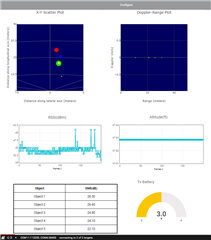Other Parts Discussed in Thread: AWR1642
Greetings forum!
I am using mmwave demo visualizer 3.6 to visualizer data generated by AWR1642BOOST running mmwave SDK 3.6.
I am generating data on a remote location and want to observe the same on my PC at a few meters distance. I have achieved this with the help of an IoT radio link.
There is a bottleneck on the data rate that can be accomodated by the IoT device so i reduced the baud rate on the DATA_PORT and hardcoded 115200bps in the CLI.c file of out of box demo running on the device.
I can observe the data on a terminal software like hyper terminal/docklite and it is being generated perfectly even when the baudrate is as low as 38400bps for example. The GUI works fine only with 921600bps baudrate set on the mmwave device. I have bypassed the initialization validation etc as well on both sides including mmwave device as well as GUI and I can receive data on data port as soon as i turn on the radar device. However, as i reduce the data to any value below the default/recommended value of 921600bps. The GUI does not register the data frame at all. I tried debugging the application using the chrome developer options by first importing the project into GUI composer and clearly observed that although the callback function is invoked on data being received at the data port but it does not register it as a valid data.
There are limitations on the radios being used that I cannot increase the baudrate on the radio receiver which receives the wireless data and sends over the UART beyond 115200bps.
Rest assured that I have reduced the frame periodicity to 1Hz only and I am not sending Range profile of other parameters. I am just sending detected objects information on the UART so my data frame size is normally 224 bytes per second. This data can even be handled by baud rates as low as 4800bps.
Please guide me how to modify the GUI source code and achieve the needful. There is some timeout or some hidden check on the baudrate that i cannot seem to find in the application files, maybe somewhere in the serial
driver which is beyond the scope of my work and I dont want to waste any more time on this right now
Best Regards
Ali Awam


